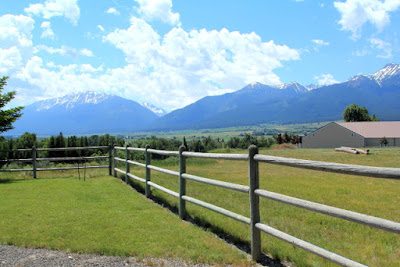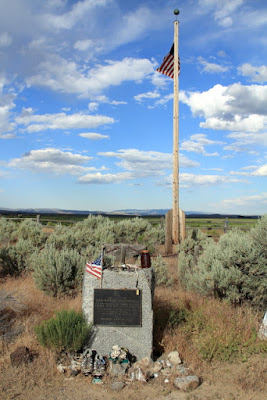After leaving the Kootenai Health Care Facility in Coeur d'Alene, we decided to start the drive home so that we could make it back to Las Vegas in two more long days!
As we drove through the small town of Worley (population 257) I couldn't help but notice the number of large grain elevators in town. This is obviously a farming area.
The "Trail of the Coeur d'Alenes" (Hn'ya pqu'nn Trailhead) starts at the Veterans of The Schitsu' Umsh Park, just north of Plummer. Also located in the park is a metal sculpture and a Medicine Tree that was planted as a tribute to the historic "Grandfather Tree," which was a located near Worley; but was taken down in 2007 to make way for a new highway.
In 1876 the Coeur d'Alene Tribe failed to find enough buffalo in the Cataldo area, so they moved south where the soil was better for farming and established a new Jesuit Mission. We did not find any mission ruins, but there was a historic marker by the side of the road (GPS coordinates 47 08.946 -116 54.655) indicated that this was the site of the relocated DeSmet Mission.
At the top of the hill overlooking the Lewiston/Clarkston area, there is a nice view area that contains three historic markers.
Marker #176 notes that in September 1812, Donald Mackenzie set up a fur trading post along the river for the John Jacob Astor Pacific Fur Company. He built a store and two houses out of driftwood, but then discovered that there were very few beaver in this area, so he abandoned the post in 1813.
Marker #167 explained that Lewiston was named the first Idaho Territory Capital on July 10, 1863, and the first two legislatures met here. In 1863, when Lewiston was the Capital, the Territory was a large area that included Idaho, Montana, and almost all of Wyoming. In 1864, Montana was established as a separate territory and most of Wyoming became part of Dakota Territory, so the Capital of Idaho was moved to Boise, where it is still located.
Marker #314 indicated Lewis Clark State College was established in Lewiston in 1893 as a two year normal school to train teachers. It is now a four-year state college.
Clarkston (Washington) is just across the river from Lewiston (Idaho), but it is considered to be part of the Lewiston Metropolitan Area.
Driving south from Clarkson there are beautiful views of the Wallowa Mountains.
Enterprise (Oregon) only has a population of 1,940, but it is the Wallowa County seat and a popular tourist destination. There are numerous artists, craftsmen, and musicians that reside in Enterprise and there are two bronze foundries that produce original works of art.
Joseph is a picturesque town just south of Enterprise and is also a tourist destination with a lot of arts and crafts shops. The town is named for Nez Perce Chief Joseph (1840-1904) and is know as "Oregon's Little Switzerland." In September they have "Alpenfest," which resembles Oktoberfest, but according to the Chamber of Commerce there is more yodeling and alphorn playing.
Chief Joseph is buried just south of town in a meadow surrounded by wildflowers.
Elgin is a small town that was established to support the farming and logging industries. The local leaders also wanted to attract a little culture to the area, so in 1912 they built an Opera House that is still in use today.
Jordan Valley is a small town near the Idaho border and has the distinction of having the only Basque handball court in the State of Oregon.
This area was primarily settled by Basques emigrants to herd sheep. The Basques emigrants brought their own language, religion, and sports with them and their favorite sport was pelota (handball). Jordan Valley's fronton (handball court) was constructed in 1915 by Basque masons who built the court from hand-hewn stones found just east of town. However, in the 1930s and 1940s, the younger generations of Basques lost interest in handball and started playing American sports.
Jean Baptiste "Pomp" Charbonneau (1805-1866) was the son of Sacajawea and Toussaint Charbonneau. "Pomp" was born at Fort Mandan and became the youngest member of the Lewis and Clark expedition. When Sacajawea died in 1812, William Clark became "Pomps" guardian and schooled him in St. Louis. At age 18 he "traveled to Europe where he spent six years becoming fluent in English, German, French, and Spanish. Returning to America in 1829, he ranged the far west for nearly four decades, as mountain man, guide, interpreter, magistrate, and forty-niner. In 1866 he left the California gold fields for a new strike in Montana. Contracted pneumonia enroute, reached "Inskip's Ranche," here, and died on May 16, 1866." He is burred near the remains of the old Inskip Ranch House on the plains of Oregon. (GPS coordinates 42 57 06.94 -117 20 21.17)
U.S. Route 50 is a major highway that runs east-west across the United States from Ocean City, Maryland to Sacramento, California. Author William Heatmoon stated that U.S. 50 was "for the unhurried, this little-known highway is the best national road across the middle of the United States" and on July 7, 1997, Time magazine devoted an entire issue to Highway 50 and called it the "Backbone of America." The Nevada portion of Highway 50 is known as "The Loneliness Road in America," due to the remoteness and lack of population in this part of Nevada. Driving this road should be on everyone's bucket list.
Austin (Nevada) is a small town (population 192) on Highway 50 that has a rich mining history with a population that has varied widely with the various mining strikes.
Silver was discovered when a Pony Express rider's horse kicked over a rock and the rider noticed the silver. A town sprang up on the site and soon had a population of more than 10,000 people. After the silver played out, the population dropped until about 1910 when new ore deposits were discovered. Once again the population increased and then decreased until the 1950s when uranium was discovered in the area. The population increased and then after a few years decreased again. Austin is now considered to be a "living ghost town" and an example of an early Nevada mining town. The International Hotel is said to be the oldest hotel in Nevada. Stokes Castle, located just outside of town, is a three-story stone tower that was constructed in 1897 by a wealthy eastern capitalist who had a financial interest in several local mines. It was occupied for only a month and then abandoned.
The Hickison Petroglyph Recreation Area is located about 24 miles east of Austin on Highway 50 near Hickison Summit. There are self-guided tours along various trails near the picnic area
Eureka bills itself as "The Friendliest Town on The Loneliest Road in America." With a population of 610, Eureka is the county seat and by far the largest community in Eureka County.
In 1864 a miner discovered rich ore in the area and shouted "Eureka!"; thus, the town's name. Soon the first important lead-silver deposits in the nation were developed and during the boom of the 1880s there were 16 smelters, over 100 saloons, an Opera House, a population of over 10,000 and a railroad that connected with the Transcontinental Line 90 miles to the north. Unfortunately, the boom was short lived and Eureka is now considered to be another "living ghost town" along Highway 50.
Now to get my truck fixed so that we can be back on the road again!













































No comments:
Post a Comment